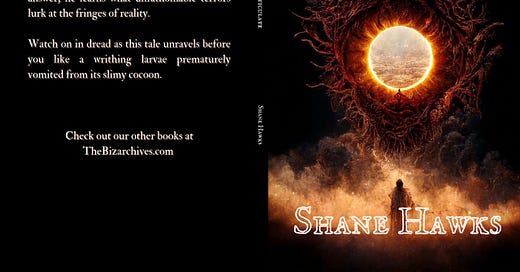Flesh Into Something Weird: A Review of Shane Hawks's "The Molybdus Articulate"
The Arbo Files
When it comes to pulp literature, there are two archetypes that stand out above the fray. The first, while not a splash when it first debuted in the late 1920s in magazines like Weird Tales, has increasingly come to define the epoch and the genre. I am speaking of course of the Lovecraftian weird tale — the cosmic horror world inhabited by learned but lonely men who are driven insane by revelations of ancient antediluvian gods and their associated cults. Horror in the twentieth and twenty-first centuries is unthinkable without this tradition, which, like most good things, began in the pulp magazines as entertainment designed for the working man.
The second archetype actually began before the pulp era, but it took the pulps, especially Black Mask, to take the inchoate form and perfect it. This is of course the hard-boiled detective — the tough, streetwise private investigator with an experienced fist and well-used gun. It is still up for debate who created the hard-boiled PI (loads of evidence points to Carroll John Daly), but few refute the fact that Dashiell Hammett and Raymond Chandler perfected the archetype.
Bizarchives veteran writer Shane Hawks’s new novella, The Molybdus Articulate, brings the two primary pulp archetypes together in a story featuring a private eye on the hunt after a strange artifact. Edmond Jameson is a New England gumshoe presumably working out of the city of Boston. In 1934, Jameson is hired by a wealthy and eccentric man named Benjamin Hammond. Hammond hires Jameson to track down the whereabouts of a traveling salesman named Maynard, who left behind a bizarre journal about a small town near Ellsworth (maybe Ellsworth, Maine?). In this town, the journal’s author lost his mind and descended into a spiral of madness. Hammond, who found the journal at an estate sale in Gloucester, Massachusetts in 1931, is interested in locating the salesman and in learning more about his uncanny experiences.
What follows is an intense, mentally destabilizing story. Jameson manages to find the strange little town, called Port Cairn, and its daemonic lighthouse, both of which are mentioned in Maynard’s journal. However, Jameson’s case not only takes a disturbing turn, but it goes completely haywire as soon as the private eye begins having flashbacks involving dead friends, his family, and the seemingly halcyon days of 1908. From there, Jameson encounters a shape-shifting landlady, an unspeakable cult holding blasphemous rights in the lighthouse, and the novella’s titular object, which the grand antagonist describes as a type of “communion” that acts as a “beacon…guiding wayward souls to seek it’s cleansing light…” The infernal object is further described thusly:
The Molybdus Articulate was both roughly hewn and intricately refined, as though intentionally so as to be unassuming. Its irregular surface was of deepest sable iridescence but as it turned there appeared to be translucent properties and when the light struck the irregular facets the Articulate multiplied and magnified, stretching and scattering, careening and coalescing.
The Articulate eventually self-destructs (kind of ) and shows Jameson that there are things beyond death and even existence. Jameson learns too that consciousness is false, and in its stead is a communion with everything that has come before. Suffice it to say, The Molybdus Articulate is a mind-bending tale, and readers feel Jameson’s alienation as he realizes his own connection to the Articulate and its power. More to the point, Jameson learns that his flesh is just a vessel for something impossible to fathom.
Hawks’s novella is truly frightening because it is so disorienting. This is not a story that foreshadows much, and its conclusion, while fitting, does not provide catharsis. In a word, it is perfect cosmic horror. One must commend Hawks for using a private eye character but abstaining from typical hard-boiled language. The Molybdus Articulate contains a prose not quite purple, but far from the streamlined, tough guy patois of Hammett or James M. Cain. It is smart writing, which is befitting a thinking man’s pulp.
The Molybdus Articulate owes a major debt of gratitude to the Old Man of Providence, but it is far from a Lovecraftian pastiche. Hawks, like the rest of the Bizarchives authors, has created his own weird tale trail that includes familiar concepts, but also novel approaches. This novella is something new and something wicked, and all of that is thanks to Hawks, a world-class talent. More must come from his pen, and the sooner the better.
The Molybdus Articulate is new pulp for the masses eschews the familiar while also being faithful to the weird tale tradition. One cannot ask for more than this. Hawks delivers and then some. The Molybdus Articulate, like the Mad Arab’s tome, demands to be read, even thought it will drive you insane.
So, read it already.




